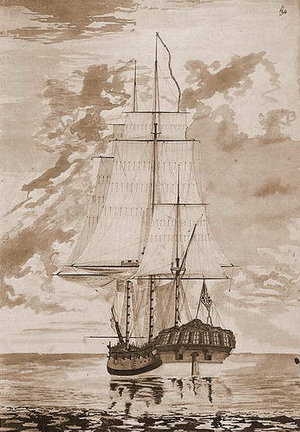|

The HMS Resolution. Watercolour
by Henry Roberts. The HMS Resolution was one of the two ships, in which Captain James Cook made his second circumnavigation of the world (1772–1775). On Blumenbach’s initiative, many of the objects collected on this journey were given to the Academic Museum of the University Göttingen. |
|
The edition von Blumenbach’s works and collections is intended to fill a critical gap in the primary sources for late-Enlightenment and Romantic cultural history. Closing this gap is of special importance for the study of one of the most important aspects of this period: the rise of the modern natural sciences.
| • |
a digital reprint of Blumenbach’s original works including their translations and reissues |
| • |
a reconstruction of his collection of natural historical objects |
| • |
hyperlinking of the digital texts and objects |
| • |
an annotated calendar of Blumenbach’s correspondence |
| • |
biographical studies of Blumenbach. |
The critical edition of Blumenbach’s works will include commentary and explanatory notes. Moreover, it will recreate an essential research process of the Enlightenment and Romantic period. A key topic of the international scientific dialogue at the time was “man” in his physical, medical, sociopolitical and cultural aspects – which dialogue was conducted via the then common means of communication, such as letters, lectures, reviews, journal articles, and monographs.
The edition of the works will be presented primarily in electronic form; towards the end of the project, individual works will also be published in book form. |
| Blumenbach’s scientific collections |
| An important factor in the development of biomedical and geological sciences was the creation of natural history collections and museums of natural history. An “Academic Museum” was also established in Göttingen in 1773. Blumenbach, an indefatigable collector, made a considerable contribution to this museum. In his works, for example in Handbuch der Naturgeschichte and in Abbildungen naturhistorischer Gegenstände, Blumenbach refers explicitly to individual objects, including type material from the first descriptions of various fossil and recent organisms. Many of the original objects have been dispersed but are still to be found in various Göttingen collections. The project “Johann Friedrich Blumenbach – Online” intends to bring these objects together again in a virtual environment and link them to Blumenbach’s writings. |
| Hyperlinking of the digital texts and objects |
| The project „Johann Friedrich Blumenbach – Online“ will make Blumenbach’s works accessible in digital form using the tools of the Internet, including hyperlink technology and links to external databases. |
| Annotated calendar of Blumenbach’s correspondence |
| About 4,500 items of Blumenbach correspondence have been preserved, covering the period 1773–1840. A calendar with brief descriptions of contents is planned, allowing for linkages with published writings and objects of natural history. |
| Biographical studies of Blumenbach |
| As the editing project develops, contributions will be made to a scientific biography and metabiography of Blumenbach. |
| Publications about the project |
| Kerzel, Martina; Reich, Mike; Weber, Heiko: „Die Edition »Johann Friedrich Blumenbach – Online« der Akademie der Wissenschaften zu Göttingen.„ In: Neuroth, Heike; Lossau, Norbert; Rapp, Andrea (ed.): Evolution der Informationsinfrastruktur. Kooperation zwischen Bibliothek und Wissenschaft. Glückstadt: Verlag Werner Hülsbusch, 2013, p. 107–136; digitised version. |
| Lauer, Gerhard; Weber, Heiko: „Johann Friedrich Blumenbach – Online“. In: Rupke, Nicolaas ; Lauer, Gerhard (ed.): Johann Friedrich Blumenbach: Race and Natural History, 1750–1850. London und New York: Routledge, 2019 [erschienen: Juli 2018], p. 16–24; digitised version via the author’s hompepage. |
|
|
